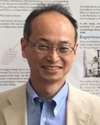Tutorial Speaker
"Plasma process-induced damage-modeling and characterizations"
Dr. Koji Eriguchi

Professor,
Kyoto University
Abstract
The increasing demand for higher performance of ULSI circuits requires aggressive shrinkage of device feature sizes in accordance with the scaling law. Plasma processing plays an important role in manufacturing advanced MOSFETs. During plasma processing, it is widely known and accepted that the interactions between plasma and devices are leading to the degradation of devices. This lecture will discuss these negative aspects of plasma processing, i.e., plasma process-induced damage (PID). During the last three decades, tremendous efforts have been devoted to clarify the mechanisms and impacts of PID on the performance of MOSFETs. This lecture will focus on one of the PID mechanisms-ion bombardment damage (plasma-induced physical damage: PPD). Since PPD mechanisms are in nature inevitable and the thickness of a damage layer is no longer negligible compared to the feature sizes of devices, PD has become one of the emerging topics in ultimately scaled MOSFET regimes such as FinFETs and atomic layer etching technologies. This lecture will deliver an overview of PPD mechanisms in terms of modeling and characterization techniques.
CV
Koji Eriguchi has been a professor of Kyoto University since 2016 after joining Kyoto University in 2005, working on plasma-solid surface interaction, optical characterization techniques of Si surfaces, and the modeling of plasma process-induced damage (PID) and the related defect creation in crystalline Si substrates and dielectric films, particularly, the degradation of materials and devices in harsh environments. Prior to joining Kyoto University, he had been a senior engineer at Panasonic from 1991, responsible for the research of plasma etch processes, thin gate dielectric wear-out phenomena under electrical stress and plasma irradiation (charging), CMOS process integration, and reliability of electronic devices. He has published more than 100 journal papers and delivered many invited talks at major international conferences. He received the Best Paper Award from the 32nd Dry Process Symposium in 2009, the APEX/JJAP Paper Award, the Plasma-Electronics Award from the Japan Society of Applied Physics (JSAP) in 2010, and 2015 Dry Process Symposium, Paper Award.
"Ultra Clean Technology Concept and Results"
Dr. Yasuyuki Shirai

New Industry Creation Hatchery Center, Specially Appointed Professor,
Tohoku University
Abstract
We have been developing Ultra Clean Technology to establish Scientific Semiconductor Manufacturing since the 1980's. Achieving 100% product yield requires a high- performance process with perfect uniformity and complete reproducibility throughout the entire processes without fluctuations. Three principles of Ultra Clean Technology are (1) Ultra Clean Processing Environment, (2) Ultra Clean Wafer Surfaces, (3) Perfect Parameter Controlled Process, that are important in establishing such processes. We have been developing Super Cleanroom Technology, Ultra Clean Gas Technology, Ultra Clean Wet Process Technology, etc. based on these three principles. Many research results have been introduced to the semiconductor manufacturing field. In technological development, progress in measurement and evaluation technology is very important. In this report, we will once again confirm the concept of Ultra Clean Technology and introduce the research and development results and current efforts, while also mentioning the importance of evaluation technology.
CV
Yasuyuki Shirai received the M.E. degree in industrial chemistry from Saga University, Saga, Japan, in 1992 and the Ph. D. degree in electronic Engineering from Tohoku University, Sendai, Japan, in 1998. In 1992-2006, he worked Fujikin Incorporated, Osaka, Japan. Since 1993, he has been visiting researcher of Tohoku University. In 2006, he moved to Tohoku University and he is presently a specially appointed professor at New Industry Creation Hatchery Center, Tohoku University. He is currently engaged in research on super cleanroom system, ultraclean gas system and ultraclean wet process.




